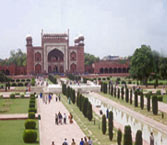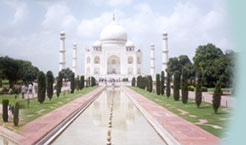|
The Taj Mahal in Agra is the glory of India. It is a monument that has become the symbol of the entire country to the world. For the Tourists visiting India from other countries of the world, the Taj is one of the first things to watch in India and remember forever. This spellbinding monument built by an inconsolable Mughul emperor Shahjahan after the death of his wife, continues to captivate generations of tourists. For experts in architecture, historians, and research scholars, the Taj offers a subject too vast, too complicated to comprehend. This is why scores of scholars continue to study the Taj Mahal architecture in order to get a better understanding of the intricacies of Mughul architecture that reached its zenith in the Taj.
Long before the first scaffolds were put in place, the nature of the proposed mausoleum had been decided. It was to be a rauza, a tomb set inside a garden. It was also to be a place of pilgrimage, as empress Mumtaz Mahal had died in childbirth, thus attaining martyrdom. According to some experts, the whole complex including the Taj was to be a replica of heaven as described in the holy Quran. All these considerations contributed towards the eventual design and plan of the monument.
According to legends about the Taj, before dying, Mumtaz Mahal asked her husband to construct for her a tomb such as the world had never seen. Shahjahan responded by assembling a team of the best artisans from India and neighboring countries. The chief architect, or mimar i kul, was Ustad Ahmed of Lahore, and Muhammad Hanif was appointed as master mason. Some accounts also credit an Italian architect for the design, but no such claims have been supported by facts. It is well known that although the designs were drawn up by the chief architect, the concept and inspiration for the Taj came from the emperor himself.
The architecture of Taj Mahal is a complex and unique blend of Persian, and indo Islamic styles. The indo Islamic style had been quite developed by the time the Mughuls came to India. They further added to the style by incorporating the charbagh garden concept and various Persian elements. For the Taj, the chief influence was to be Persian, but the harmony achieved reflects a careful and deliberate blend of the purely Indian styles. One of the striking features of the Taj Mahal architecture is the flawless symmetry maintained throughout the complex.
As the Taj was to serve as a tomb, a pilgrimage as well as a festive hall, all the necessary aspects were incorporated into the design. Thus, the Taj included provisions for shops, large assemblies, and the charbagh garden - a typical Mughul feature with footpaths crossing at right angles. The raised pool at the center is also a characteristic feature of Mughul gardens. It is supposed to duplicate the Garden of Eden, and reflects the monument as one goes closer.
The mausoleum measures 57 meters on each side, and rises to a height of 32 meters (108 feet). The dome and the finial rise to 72 meters. The surrounding terrace measures 95 meters (313 feet) on each side. The minarets on the four sides have been deliberately kept at a height lower than the dome, to accentuate the greatness of the main structure. The chatris (kiosks) on top of the mausoleum and the minarets are glaring examples of the fusion of Indian elements in the Taj.
The outstanding pietra dura inlay work using precious and semi precious stones is the icing on the cake for Taj Mahal architecture. In addition to this the intricate calligraphy found all over the mausoleum highlights the religious significance of the building.
The architecture of Taj Mahal is still being studied by experts who hope to uncover newer aspects of the amazing architecture. The Taj Mahal represents the combined result of centuries of synthesis between the architecture of regions separated by thousands of miles across the world. It can be said to be one of the truly international monuments that has brought together the traditions of many cultures together.
Learn more about the Taj Mahal and tourism in Agra in touristplacesinindia.com.
 |
| 
